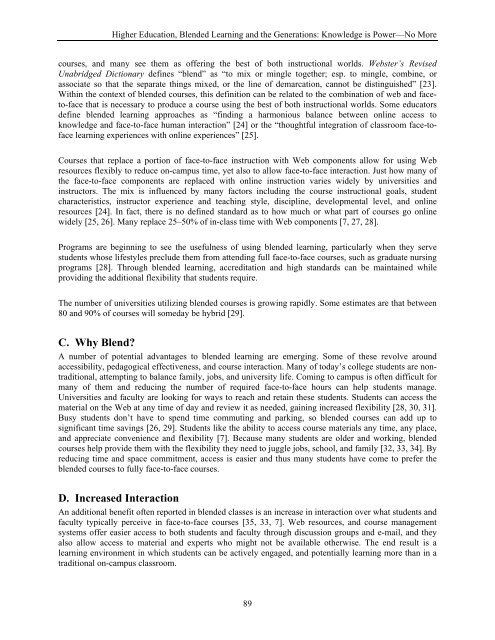Elements of Quality Online Education cation
Elements of Quality Online Education cation
Elements of Quality Online Education cation
Create successful ePaper yourself
Turn your PDF publications into a flip-book with our unique Google optimized e-Paper software.
Higher <strong>Edu<strong>cation</strong></strong>, Blended Learning and the Generations: Knowledge is Power—No Morecourses, and many see them as <strong>of</strong>fering the best <strong>of</strong> both instructional worlds. Webster’s RevisedUnabridged Dictionary defines “blend” as “to mix or mingle together; esp. to mingle, combine, orassociate so that the separate things mixed, or the line <strong>of</strong> demar<strong>cation</strong>, cannot be distinguished” [23].Within the context <strong>of</strong> blended courses, this definition can be related to the combination <strong>of</strong> web and faceto-facethat is necessary to produce a course using the best <strong>of</strong> both instructional worlds. Some educatorsdefine blended learning approaches as “finding a harmonious balance between online access toknowledge and face-to-face human interaction” [24] or the “thoughtful integration <strong>of</strong> classroom face-t<strong>of</strong>acelearning experiences with online experiences” [25].Courses that replace a portion <strong>of</strong> face-to-face instruction with Web components allow for using Webresources flexibly to reduce on-campus time, yet also to allow face-to-face interaction. Just how many <strong>of</strong>the face-to-face components are replaced with online instruction varies widely by universities andinstructors. The mix is influenced by many factors including the course instructional goals, studentcharacteristics, instructor experience and teaching style, discipline, developmental level, and onlineresources [24]. In fact, there is no defined standard as to how much or what part <strong>of</strong> courses go onlinewidely [25, 26]. Many replace 25–50% <strong>of</strong> in-class time with Web components [7, 27, 28].Programs are beginning to see the usefulness <strong>of</strong> using blended learning, particularly when they servestudents whose lifestyles preclude them from attending full face-to-face courses, such as graduate nursingprograms [28]. Through blended learning, accreditation and high standards can be maintained whileproviding the additional flexibility that students require.The number <strong>of</strong> universities utilizing blended courses is growing rapidly. Some estimates are that between80 and 90% <strong>of</strong> courses will someday be hybrid [29].C. Why Blend?A number <strong>of</strong> potential advantages to blended learning are emerging. Some <strong>of</strong> these revolve aroundaccessibility, pedagogical effectiveness, and course interaction. Many <strong>of</strong> today’s college students are nontraditional,attempting to balance family, jobs, and university life. Coming to campus is <strong>of</strong>ten difficult formany <strong>of</strong> them and reducing the number <strong>of</strong> required face-to-face hours can help students manage.Universities and faculty are looking for ways to reach and retain these students. Students can access thematerial on the Web at any time <strong>of</strong> day and review it as needed, gaining increased flexibility [28, 30, 31].Busy students don’t have to spend time commuting and parking, so blended courses can add up tosignificant time savings [26, 29]. Students like the ability to access course materials any time, any place,and appreciate convenience and flexibility [7]. Because many students are older and working, blendedcourses help provide them with the flexibility they need to juggle jobs, school, and family [32, 33, 34]. Byreducing time and space commitment, access is easier and thus many students have come to prefer theblended courses to fully face-to-face courses.D. Increased InteractionAn additional benefit <strong>of</strong>ten reported in blended classes is an increase in interaction over what students andfaculty typically perceive in face-to-face courses [35, 33, 7]. Web resources, and course managementsystems <strong>of</strong>fer easier access to both students and faculty through discussion groups and e-mail, and theyalso allow access to material and experts who might not be available otherwise. The end result is alearning environment in which students can be actively engaged, and potentially learning more than in atraditional on-campus classroom.89
















